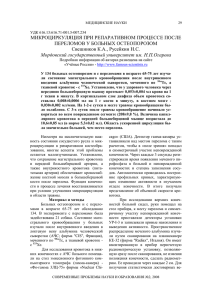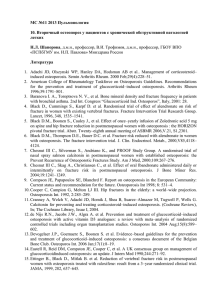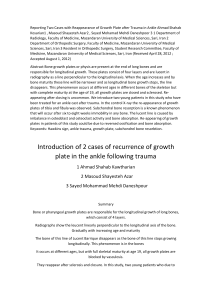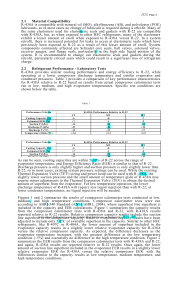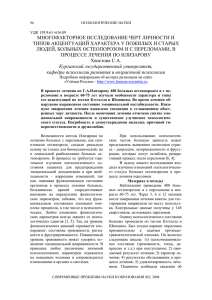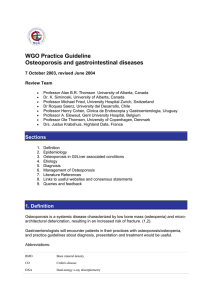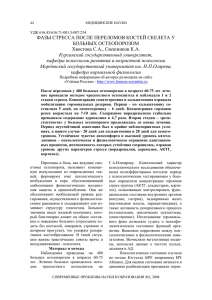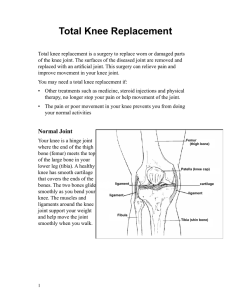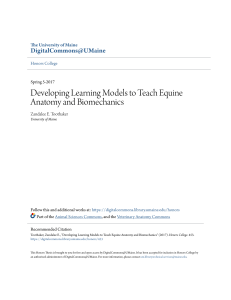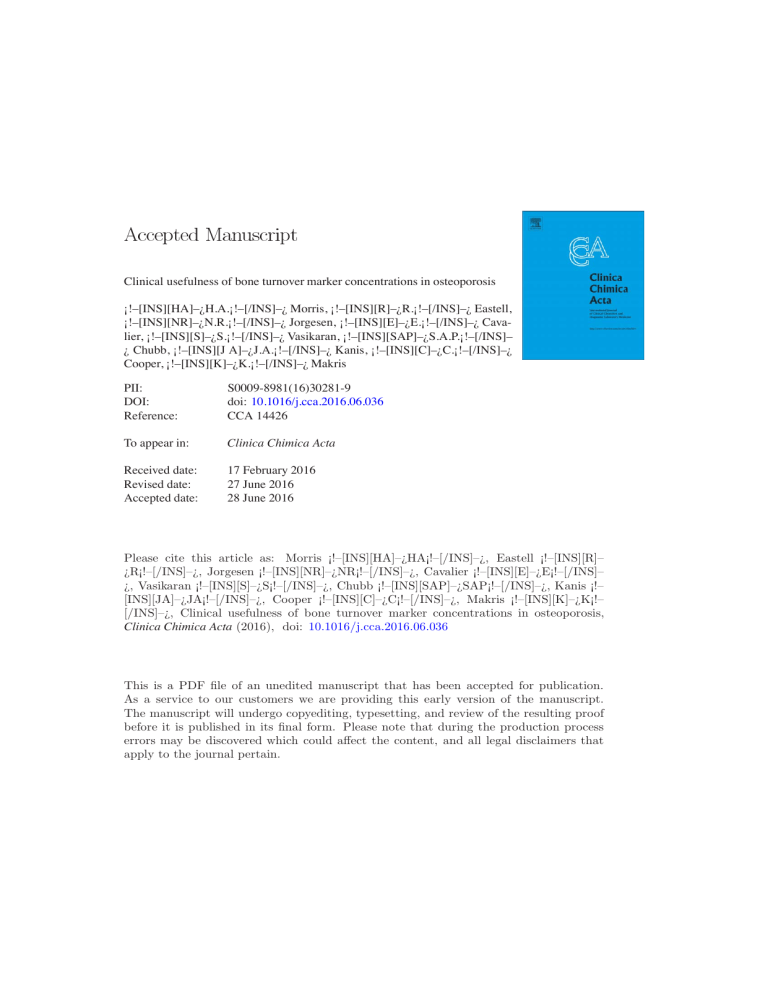
Clinical usefulness of bone turnover marker concentrations in osteoporosis ¡!–[INS][HA]–¿H.A.¡!–[/INS]–¿ Morris, ¡!–[INS][R]–¿R.¡!–[/INS]–¿ Eastell, ¡!–[INS][NR]–¿N.R.¡!–[/INS]–¿ Jorgesen, ¡!–[INS][E]–¿E.¡!–[/INS]–¿ Cavalier, ¡!–[INS][S]–¿S.¡!–[/INS]–¿ Vasikaran, ¡!–[INS][SAP]–¿S.A.P.¡!–[/INS]– ¿ Chubb, ¡!–[INS][J A]–¿J.A.¡!–[/INS]–¿ Kanis, ¡!–[INS][C]–¿C.¡!–[/INS]–¿ Cooper, ¡!–[INS][K]–¿K.¡!–[/INS]–¿ Makris PII: DOI: Reference: S0009-8981(16)30281-9 doi: 10.1016/j.cca.2016.06.036 CCA 14426 To appear in: Clinica Chimica Acta Received date: Revised date: Accepted date: 17 February 2016 27 June 2016 28 June 2016 Please cite this article as: Morris ¡!–[INS][HA]–¿HA¡!–[/INS]–¿, Eastell ¡!–[INS][R]– ¿R¡!–[/INS]–¿, Jorgesen ¡!–[INS][NR]–¿NR¡!–[/INS]–¿, Cavalier ¡!–[INS][E]–¿E¡!–[/INS]– ¿, Vasikaran ¡!–[INS][S]–¿S¡!–[/INS]–¿, Chubb ¡!–[INS][SAP]–¿SAP¡!–[/INS]–¿, Kanis ¡!– [INS][JA]–¿JA¡!–[/INS]–¿, Cooper ¡!–[INS][C]–¿C¡!–[/INS]–¿, Makris ¡!–[INS][K]–¿K¡!– [/INS]–¿, Clinical usefulness of bone turnover marker concentrations in osteoporosis, Clinica Chimica Acta (2016), doi: 10.1016/j.cca.2016.06.036 This is a PDF file of an unedited manuscript that has been accepted for publication. As a service to our customers we are providing this early version of the manuscript. The manuscript will undergo copyediting, typesetting, and review of the resulting proof before it is published in its final form. Please note that during the production process errors may be discovered which could affect the content, and all legal disclaimers that apply to the journal pertain. ACCEPTED MANUSCRIPT Clinical usefulness of bone turnover marker concentrations in osteoporosis HA Morris1 R Eastell2, NR Jorgesen3, E Cavalier4, S Vasikaran5, SAP Chubb5, J A Kanis6, C PT Cooper7, K Makris8 on behalf of the IFCC-IOF Working Group for Standardisation of Bone 1 School of Pharmacy and Medical Sciences, University of South Australia, Adelaide SA 5000, Australia 2 Mellanby Centre for Bone Research, University of Sheffield and Metabolic Bone Centre, NU Northern General Hospital, Herries Road, Sheffield 3 SC RI Marker Assays (WG-BMA) Research Centre for Aging and Osteoporosis, , Department of Clinical Biochemistry, Rigshospitalet, Ndr Ringvej 57-59, DK-2600 Glostrup, Denmark and OPEN, Odense Patient MA data Explorative Network, Odense University Hospital/Institute of Clinical Research, University of Southern Denmark, Odense, Denmark University of Liège, CHU Sart-Tilman, Domaine du Sart-Tilman, B-4000 Liège, Belgium 5 Department of Clinical Biochemistry, PathWest Laboratory Medicine, Fiona Stanley ED 4 Hospital, Murdoch, WA 6150 Australia Centre for Metabolic Bone Diseases, University of Sheffield Medical School, Beech Hill PT 6 Road, Sheffield S10 2RX, UK The MRC Epidemiology Resource Centre, Southampton General Hospital, University of AC CE 7 Southampton, Southampton SO16 6YD, UK 8 Clinical Biochemistry Department, KAT General Hospital, 14651, Athens, Greece Corresponding Author: Professor HA Morris Email: [email protected] Phone: +618 8222 3031 Address: School of Pharmacy and Medical Sciences University of South Australia GPO Box 2471 Adelaide SA 5001 Australia ACCEPTED MANUSCRIPT Abstract: Current evidence continues to support the potential for bone turnover markers (BTM) to provide clinically useful information particularly for monitoring the efficacy of osteoporosis treatment. Many of the limitations identified earlier remain, principally in regard to the Important data are now available on PT relationship between BTM and incident fractures. reference interval values for CTX and PINP across a range of geographic regions and for SC RI individual clinical assays. An apparent lack of comparability between current clinical assays for CTX has become evident indicating the possible limitations of combining such data for meta-analyses. Harmonization of units for reporting serum/plasma CTX (ng/L) and PINP (µg/L) is recommended. The development of international collaborations continues with an NU important initiative to combine BTM results from clinical trials in osteoporosis in a metaanalysis and an assay harmonization program are likely to be beneficial. It is possible that MA knowledge derived from clinical studies can further enhance fracture risk estimation tools with inclusion of BTM together with other independent risk factors. Further data of the relationships between the clinical assays for CTX and PINP as well as physiological and pre- Highlights: PT ED analytical factors contributing to variability in BTM concentrations are required. AC CE New data support the potential for bone turnover markers to inform on fracture risk and efficacy of osteoporosis treatment. Reference intervals for CTX and PINP for geographic regions and individual assays are available. Harmonization of units for reporting serum/plasma CTX (ng/L) and PINP (µg/L) is recommended. Keywords: Bone turnover markers; osteoporosis; fracture risk; reference intervals; monitoring efficacy for treatment of osteoporosis; CTX; PINP. ACCEPTED MANUSCRIPT 1. Introduction: Osteoporosis is the most prevalent metabolic bone disease and with an aging population its impact is expected to rise throughout the world. It is defined as a disease characterised by PT low bone mass and microarchitectural deterioration of bone tissue, leading to enhanced bone fragility and consequent increase in risk of fracture [1]. Low bone mass, measured as bone SC RI mineral density (BMD), is asymptomatic and its important outcome is fracture, a cause of morbidity and mortality [2]. Therefore, the clinical management focus in osteoporosis is to prevent or reduce the risk of fracture and follow the response to therapy. Its total cost burden, including pharmacological prevention, in the European Union was recently estimated to NU correspond to approximately 3.5% of the total spending on health care at €37 billion [3]. Similar relative cost burdens are experienced in other parts of the world with the steepest rises in number of fractures in the coming years expected to be reported from the high population MA countries of Asia, all largely dependent on the ageing of the population [4]. The first line of medical testing for diagnosis of osteoporosis and estimation of risk of fracture ED whether at clinical presentation or following initiation of treatment is measurement of BMD, most commonly using dual-energy x-ray absorptiometry (DXA) [5]. Algorithms to estimate PT fracture risk based on BMD and other clinical features such as FRAX® are commonly used in clinical practice to guide the treatment of individual patients [6]. Bone turnover markers AC CE (BTM) are not included in such algorithms. BTM have a long history in research on metabolic bone diseases including osteoporosis and assays for a wide range have been developed. A review of this complete range is beyond the scope of this manuscript although others are available [7, 8]. BTM largely represent products of bone proteins, particularly type I collagen which undergoes considerable post-translational modification during synthesis of new bone and within the bone environment such that particular modifications increase the specificity for assessing bone formation or bone resorption. Other BTMs are products of bone cells, reflecting the number of particular cells within the bone environment at any time. In 2010 the International Osteoporosis Foundation (IOF)–International Federation of Clinical Chemistry and Laboratory Medicine (IFCC) Joint Working Group on Bone Marker Standards (WG-BMS) published an extensive review concluding that there were insufficient data to include bone turnover markers values in current clinical practice [9]. The Working Group recommended one bone formation marker (serum-procollagen type I N-propeptide (PINP)) ACCEPTED MANUSCRIPT and one bone resorption marker (serum C-terminal telopeptide of type I collagen, (CTX)) be used as reference markers, to be measured by standardised assays in observational and intervention studies in order to assess their clinical performance as well as provide data by PT which alternatives could be assessed thus enlarging the international experience of the application of these markers to clinical medicine. In 2012 the National Bone Health Alliance SC RI extended the literature review on this subject arriving at similar recommendations [10]. The IFCC-IOF Working Group for the Standardization of Bone Marker Assays was established in 2012 to standardize or harmonize serum/plasma CTX and PINP assays depending on feasibility. After initial discussions with representatives of clinicians, clinical NU laboratorians and the In Vitro Diagnostic industry, it was agreed that a strategy of harmonization of assays was preferable because of the current lack of data indicating their MA clinical usefulness. A project is underway to describe the relationship for CTX and PINP values generated by the various assays used by clinical laboratories for patients presenting to an osteoporosis clinic. In the first instance a statistical method will be used to harmonise ED values where the assays provide significantly different concentrations. PT 2. BTM concentrations for predicting fracture risk The IOF-IFCC WG-BMS review by Vasikaran et al described 22 studies, in which the AC CE relationship between bone turnover markers and incident fractures was examined [9]. Eighteen of them showed that one or more markers were associated with risk of subsequent fracture with the concentration of bone resorption markers more consistently associated with fracture risk than bone formation markers. This was the case for studies in both men and women. Since that time three more studies have been published including a meta-analysis (Table 1). The meta-analysis examined the performance characteristics of two BTM, PINP and CTX, for fracture risk prediction in untreated individuals. The analysis included 6 prospective, cohort studies with the first incident fracture as the primary outcome. Only studies in middle-aged or older men and women were included. The expression of risk varied between the original studies, but all results were transformed into hazard ratio (HR) per standard deviation (SD) which is the gradient of risk (GR). The meta-analysis found a modest, but significant association between both PINP and CTX concentrations at baseline and fracture risk (see Table 1) [11]. This analysis combined results for CTX generated by the two clinical laboratory automated assay methods currently available. As presented below (see Section 6) these assays do not appear to provide comparable values for CTX. Similarly the ACCEPTED MANUSCRIPT PINP data were generated by different assays and while the lack of comparability of these assays is less certain again the GR would likely be reduced by combining assay data which are not comparable. In the Australian Health In Men Study the association of bone turnover PT markers with hip fracture incidence in older men was examined. Total osteocalcin (tOC), undercarboxylated osteocalcin (ucOC) and CTX were associated with hip fractures in SC RI univariate analyses, but only tOC remained significantly associated with incident hip fractures in multivariate analyses adjusting for age and glucocorticoid use [12]. In contrast to the above, a Japanese study of the Taiji cohort of both men and women failed to demonstrate a significant association between a broad range of markers of bone formation and bone NU resorption and incident fracture risk. However, the study was insufficiently powered for a fracture endpoint as this cohort included relatively young subjects (mean age approximately 60 years) resulting in a low number of osteoporotic fractures (32) during the 10-year follow- MA up period [13]. ED These more recent findings support the previous interpretation in the Vasikaran review [9]. There are significant associations between bone turnover markers and incident fracture risk, though the association is modest. Most studies demonstrate a relation between bone turnover PT markers and fracture, yet there are limitations to the studies. These include the variable use of markers of bone formation (BAP, PINP, PICP, total osteocalcin, intact osteocalcin) and of AC CE bone resorption (ICTP, CTX, NTX-I, PYR, DPD, beta-CTX), differences in analytical assays and platforms, inconsistencies in expression of risk, as well as inconsistent predictive value for a specific marker in the individual studies reported. (See Table 1 for abbreviations of BTMs) 3. BTM concentrations for monitoring treatment The IOF-IFCC WG-BMS review [9] also reported seven studies concerning the relationship between change in BTM and fracture risk reduction with drugs given for postmenopausal osteoporosis. These drugs included alendronate, risedronate, zoledronic acid, raloxifene, and strontium ranelate. One of the outcomes from such studies is to assess the extent to which a biological marker is a surrogate end-point for a clinical event, which is known as the ‘treatment effect explained’. In the case of clinical trials for osteoporosis treatment the clinical end-point is fracture and the surrogate biological markers are BTM. In these trials the treatment effect explained varied from 27-77% indicating that about half of the fracture risk ACCEPTED MANUSCRIPT reduction with these drugs, which work through the inhibition of bone turnover, could be associated with the measured change in BTM during the first year of treatment. PT There have now been two further studies that examine this question, one a follow-up analysis of zoledronic acid and the other a new analysis with bazedoxifene, a selective estrogen SC RI receptor modulator, similar to raloxifene (Table 2). They are both believed to reduce the risk of fracture by the reduction in bone turnover. Jacques and colleagues [14] reported on the relationship of changes in PINP and fracture risk reduction in the HORIZON trial. This was a study of 7736 postmenopausal women with osteoporosis who were randomized to receive NU zoledronic acid 5 mg intravenously once a year for three years, or placebo. All patients received calcium and vitamin D. A bone marker subset analysis included 1132 women in whom PINP was measured. This marker was chosen as the samples were not taken with the MA patients in the fasting state and PINP has proven to be informative in other studies, for example with raloxifene where the mean change in PINP at 12 months was 56% [15]. The ED change in PINP at one year explained 58% of the treatment effect on new vertebral fracture (statistically significant), and there was a significant association with non-vertebral fracture. This figure was similar to the 54% treatment effect explained change in total hip BMD over PT three years and vertebral fracture. The effect explained by PINP was independent of that AC CE explained by total hip BMD, so the results of these two tests are complimentary. Bruyere and colleagues [16] reported on the relationship of changes in the BTM (CTX and OC) and fracture risk reduction in a phase 3 trial of bazedoxifene. This was a study of 5244 postmenopausal women with osteoporosis who were randomized to receive bazedoxifene 20 mg or 40 mg daily, or raloxifene 60 mg daily, or placebo for three years. All patients received calcium and vitamin D. The median reductions in response to 20 mg daily were CTX (46%), OC (37%) and for 40 mg daily were CTX (49%), OC (39%) [17]. The change in CTX at one year explained 16% and change in OC 6% of the treatment effect on new vertebral fracture (statistically significant). There was no overall reduction of non-vertebral fractures in this study so any relationship with marker change could not be tested. These figures were similar to the figures of 14% treatment effect explained by the change in total hip BMD and 5% for lumbar spine BMD over three years and vertebral fracture. Once again the conclusions made in the original report [9] are at least partially supported by these new analyses. The treatment effect explained by BTM is at least as great as BMD. The ACCEPTED MANUSCRIPT finding of significant positive associations between the reduction in BTM and the reduction in fracture risk support the use of BTM in monitoring treatment. The limitation noted in the original report that studies were often small subsets of the main trial was true for the PT zoledronic acid study but not for the bazedoxifene study, which is the largest study to date. The studies were also criticized for not obtaining samples under optimal conditions. This SC RI again was not true of these two studies as the patients from the bazedoxifene study were in the fasting state for the blood draw, a critical requirement for serum CTX. 4. The effect of renal impairment on BTM concentrations Bone health is very frequently altered in Chronic Kidney Disease (CKD) and these patients NU are at increased risk of fractures whether they are dialyzed [18] or not [19]. Indeed, these patients often are characterized by either increased or decreased bone turnover, linked to over- MA or under-secretion of parathyroid hormone (PTH). The gold standard to evaluate bone turnover is bone biopsy. Unfortunately, use of bone biopsies to determine bone turnover is hampered by the invasive nature of the procedure and the difficulty for correct interpretation ED of the results, limiting its use to a few specialized centres [20]. In clinical practice repeated bone biopsies are problematic for the follow-up of the patients or to assess effect of a PT treatment. Hence, BTM are essential in clinical practice to evaluate bone turnover. In 2009 the international recommendations in nephrology, Kidney Disease: Improving Global Outcomes AC CE (KDIGO) guidelines [21] recommended the measurement of PTH and the bone turnover marker Bone Specific Alkaline Phosphatase (BAP) in the assessment of metabolic bone disease of CKD (CKD-MBD). BAP was selected because serum concentrations are unaffected by renal function since it is cleared by the liver and with a molecular weight above 50,000 D it is unlikely to be filtered at the kidney. BAP does suffer from some analytical and clinical issues, which have been discussed elsewhere [22]. PINP has been recommended as the bone formation marker by IOF and IFCC for clinical research studies in osteoporosis [9]. It consists of three subunit chains of type 1 procollagen (2 pro-α1 chains and 1pro-α2 chain) that are non-covalently linked and is produced in equimolar amounts with collagen deposited in bone tissue [23]. Once in the circulation, PINP is rapidly bound and internalized by liver endothelial cells through their scavenger receptors [24]. In human serum, PINP is present in two major forms, an intact trimeric form and a monomeric form. This latter form tends to be elevated in CKD patients. PINP determination can be performed either with automated (Roche Elecsys/Cobas and IDS iSYS) or manual (Orion ACCEPTED MANUSCRIPT Diagnostica) methods but the “Total” PINP assay (Roche Elecsys/Cobas) recognizes both the trimeric form and the monomers whereas the “Intact” PINP assays (IDS iSYS and Orion Diagnostica) recognize the trimeric form only. In CKD patients, it has been shown that PT patients with a glomerular filtration rate (GFR) below 30 ml/min/1.73 m2 have PINP concentrations that are overestimated by the “Total” assay due to the cross-reactivity with the SC RI monomeric form [25]. Assays specific for “Intact” PINP are recommended for use with CKD patients. While IOF and IFCC recommend serum CTX as the bone resorption biomarker for clinical NU research studies in osteoporosis it is not recommended in CKD-MBD by the KDIGO guidelines since serum PTH or BAP are more effective at predicting clinical outcomes or bone histology [21, 26]. Serum CTX concentrations in patients undergoing haemodialysis are MA some five times higher than those of the normal population due to its accumulation with decreased renal function and frequent secondary hyperparathyroidism [26]. Tartrate resistant ED acid phosphatase 5B (TRAP-5B) may be a suitable alternative for the monitoring of the bone resorption in CKD patients as it presents very interesting features: its serum concentrations are not influenced by kidney function and it is a non-collagen bone resorption marker with PT serum concentrations significantly correlating with histological indices of osteoclast number, bone formation rate and mineral apposition rate in uremic patients [27]. By the same token, it AC CE is not a good marker of change in bone resorption following treatment with cathepsin K inhibitors, which reduce bone resorption without reducing osteoclast numbers. TRAP-5B has recently become available on the automated IDS iSYS platform which may increase its potential as a routine marker for clinical laboratories increasing the data on this marker since such information is scarce [26]. Fibroblast Growth Factor 23 (FGF23) is produced by osteocytes and is increased in CKD patients. High concentrations of FGF23 are associated with improved indices of skeletal mineralization in dialyzed pediatric patients with high turnover renal osteodystrophy [28]. Thus, FGF-23 measurements may indicate skeletal mineralization status, at least in this population [29]. However, since concentrations of FGF23 are extremely high in CKD patients compared to healthy individuals, it would appear unlikely that subtle changes in FGF23 concentrations will be clinically significant. These high concentrations add to the difficulty of measuring FGF23 with current manual assays. It is unclear whether such highly diluted specimens provide values that reflect the true value in serum or whether matrix effects ACCEPTED MANUSCRIPT confound these results. New studies, with better analytical tools, are needed to prove the usefulness of FGF23 to reflect bone mineralization in CKD patients. PT Sclerostin, also produced in the osteocytes, is an inhibitor of the Wnt signalling pathway thus decreasing bone formation [30]. Sclerostin is an independent predictor of bone loss in CKD SC RI patients on dialysis [31]. High concentrations of sclerostin have surprisingly been found in dialysis patients with higher bone volume and density and it is unclear whether sclerostin has a true protective effect or if these high values arise as a secondary phenomenon [32]. Sclerostin accumulates in CKD which adds further complexity for interpretation of results NU [33]. Even more problematic is the lack of concordance between the different assay kits confounding the interpretation of serum levels [34]. With a new anti-sclerostin agent becoming available, interest in this analyte will likely grow but robust analytical methods are MA required to provide true measurements suitable for clinical interpretation. ED 5. Interpretation of bone turnover markers concentrations – the role of reference intervals BTM reference intervals are useful for interpreting the results from osteoporosis patients but by themselves they are of limited value for fracture prediction in untreated, individual PT patients. The measurement of very high BTM values (> 3 standard deviations above the mean of the reference values) during initial assessment of patients with osteoporosis is suggestive of AC CE other metabolic disease including malignancy [9]. The need to establish reference intervals from healthy premenopausal women aged 30-45 years when concentrations are at a nadir has been emphasised [9, 35]. Ideally the subjects used for these studies should have normal BMD at the spine [9]. Expert opinion also suggests that the mean of the premenopausal reference interval can be used as a treatment target for anti-resorptive therapy [9, 35]. It is considered necessary to establish reference intervals for different geographic areas and ethnicities [9]. Furthermore due to differences that currently exist between results from the different commercial clinical assays, current reference intervals need to be method specific; reference intervals from different methods cannot be used interchangeably. The following data providing reference interval data for CTX and PINP from various countries and assays are summarized in Tables 3-6. de Papp et al studied healthy premenopausal women from across the US including users and non-users of the oral contraceptive pill [OCP]. Serum samples were collected in the morning ACCEPTED MANUSCRIPT after an overnight fast. CTX values were log transformed to obtain a normal distribution and the geometric mean ±2 SD was used to determine the overall mid 95% range for CTX (Table 3). Data from Italian healthy premenopausal, non-OCP using women aged 20-49 years were PT examined for the central 95% distribution for PINP and CTX [37]. Serum samples were collected between 7.30 am and 8.30 am after an overnight fast. BTMs were considerably SC RI higher in women aged 20–25 years and decreased progressively until 45–50 years of age. The reference intervals in women aged 45–50 years are presented in Tables 3 and 4. Healthy French premenopausal, non-OCP using women provided serum samples after an overnight fast before 10 am. The 2.5th to 97.5th percentile distribution for CTX and PINP are shown in NU Tables 3 and 4 [38]. Reference intervals for English premenopausal, non-OCP using women were established from serum samples collected between 8 am and 10 am after an overnight fast. Data for serum CTX and PINP were log transformed and 95% reference interval was MA calculated as mean±1.96 SD (Tables 3 and 4) [39]. ED French, Belgium, US and UK healthy premenopausal women including OCP non-users and users provided serum samples collected between 8 and 10 am after an overnight fast [40]. CTX and PINP values were log transformed to achieve normal distributions (Tables 3 and 4). PT Healthy premenopausal Saudi Arabian, non-OCP using women provided serum samples collected between 9:00 and 11:00 am after an overnight fast [41]. The central 95% calculated AC CE for each BTM (Tables 3 and 4). A cross-sectional registry study examined premenopausal healthy European Caucasian women not on OCP from France and Denmark [42]. Serum samples were collected after an overnight fast between 08:00 and 09:30 am. BTM data were log transformed to obtain a normal distribution and the reference intervals were determined as mean±1.96 SD for normalized values (Tables 3 and 4). An Australian study that included premenopausal women from the Geelong Osteoporosis Study examined reference intervals by decades of age [43]. Serum samples were collected after an overnight fast between 07:30 and 11:45 am and stored at -800c for >10 years. Optimal age-related reference intervals were determined for each BTM based on the central 90% of the distribution (Tables 3 and 4). Harmonized reference intervals for use in Australia have been developed for automated Roche assays for CTX and PINP based on published studies listed above with most weighting given for the Australian data [44, 45]. ACCEPTED MANUSCRIPT Serum samples were collected from healthy premenopausal Spanish, non-OCP using women between 8 and 10 am after an overnight fast [46]. A quantile regression was used to estimate the 5th, 50th and 95th percentiles. The reference intervals are provided in Tables 3 and 4 for the PT automated Roche assay and Tables 5 and 6 for the automated IDS iSYS assay. The German Study of Health in Pomerania examined healthy premenopausal women after excluding those SC RI with any predetermined illness, OCP use or serum 25-hydroxyvitamin D concentration less than 25 nmol/L. Blood sampling was performed between 8.00 am and 8.00 pm from the mostly non-fasting subjects [47]. Reference intervals were defined as the central 95% range between the 2.5th and 97.5th percentiles (Tables 5 and 6). Note this study included mostly NU non fasting subjects and sampling was performed throughout the day. Morovat et al studied apparently healthy premenopausal women as part of a larger study in two centres [48]. No mention is made of OCP use. Serum samples were collected during working hours in Belgium MA and between 8.30 am and 3.00 pm in UK. PINP was measured by automated IDS-iSYS assay. PINP values were log transformed to obtain a normal distribution and the 95% reference ED interval determined and calculated values were converted back to measured units (Tables 5 and 6). PT The largest variation between the reference intervals appear to be between the Roche and IDS-iSYS assays for CTX although data for the IDS-iSYS assay are limited. The variation AC CE across geographic regions appears to be minor except for those from Saudi Arabia. Possibly data from other regions are largely derived from Caucasian populations and therefore there remain limited data from other ethnic groups as discussed previously [9]. 6. Comparability of PINP and CTX values generated by current clinical assays As discussed previously currently there are three clinical assays available for PINP and for CTX in blood. EDTA plasma has been stated as the preferred specimen type for the assay of CTX and is identified as such when specific reference is made. PINP is less affected by specimen type. The relationships between results produced by these different clinical assays for CTX and PINP have been examined. Note that CTX is variously reported in units of ng/L or ng/mL; in this review all results are converted to ng/L. P1NP is reported in µg/L in most studies. Koivula et al examined the relationships between the PINP results produced by two assays, the automated Roche Elecsys 2010 assay which measures total PINP and the ACCEPTED MANUSCRIPT radioimmunoassay for intact PINP (Orion Diagnostica UniQ PINP) [49]. The subjects were: 34 apparently healthy blood donors (26 men, 8 women; ages between 19 and 62 years), 39 patients with chronic renal failure and 173 bedridden geriatric (age >65 years) in-patients. The PT serum samples were kept frozen at -200C till analysis. The Passing-Bablok regression data are given in Tables 7 and 8. They concluded that PINP concentrations were similar in healthy SC RI blood donors but different in haemodialysis or bedridden geriatric patients with the Roche assay giving significantly higher results. In the most extensive study of P1NP methods, Morovat et al compared automated Roche E170 Total PINP and IDS iSYS Intact PINP in 828 serum specimens from healthy individuals and osteoporotic patients [50]. This study is NU notable for including a significant number of healthy children (>45% of the whole cohort), which had the effect of extending the range of P1NP values in the comparison. The relationship between the two assays was non-linear. Overall the iSYS results were MA significantly higher than those obtained by the Roche E170 but at total PINP concentrations of < 100 μg/L and > 670 μg/L, the iSYS assay gave lower values than the E170 assay. ED Cavalier et al compared the automated Roche Elecsys Total PINP and IDS iSYS Intact PINP assays in two populations; 157 patients in stage 3–5 CKD and 125 patients in stage 5D patients [51]. They concluded that the two assays produce the most discrepant results when PT eGFR decreases below 30 mL/min/1.73 m2 although discrepancy is apparent even for eGFR AC CE values between 30 and 60 mL/min/1.73 m2 (Table 8). Wheater et al examined the relationships between the results produced by two automated systems, Roche Elecsys 2010 and IDS iSYS, for PINP and CTX in blood from 127 subjects: 72 self-reported healthy volunteers (28 males, 28 females < 50 years and 5 males, 11 females > 50 years) with no known bone disease and 55 rheumatoid arthritis (RA) patients (1 male, 4 females < 50 years and 10 males, 40 females > 50 years) [52]. All patients had an estimated glomerular filtration rate (eGFR) > 30 mL/min/1.73 m2. Serum samples were stored at -800c immediately after venepuncture and used for both assays. The Passing-Bablok regression data are shown in Tables 7 and 9. Whereas the P1NP assays appeared to give equivalent results, these authors found significant proportional and systematic biases between the CTX assays. Chubb et al measured plasma CTX by all three commercial assays on 169 adult patients (119 females and 50 males, median age 65 years [inter-quartile range 57–75.75] years) attending hospitals for routine investigation of metabolic bone disease including osteoporosis [53]. EDTA plasma was frozen at -200c before analysis after storage at 40C for up to 7 days. They also found significant proportional and systematic bias when the IDS iSYS assay was ACCEPTED MANUSCRIPT compared to both the IDS ELISA and Roche methods. The Passing Bablok regression parameters are given in Table 9 and 10. In contrast, in a conference abstract, Cavalier et al. reported no systematic bias and lower proportional bias (the slope of the regression line was PT 1.12) between the Roche and IDS iSYS automated assays for CTX [54] (Table 9). Huvelle et al compared CTX results by the IDS iSYS assay and the IDS ELISA on 97 serum samples SC RI collected from patients presenting to hospital for bone and mineral metabolism work-up (females 78; males 19; mean age: 67 years) [55]. Their regression data are shown in Table 10. They concluded that their limited study suggested the two assays could be used NU interchangeably. In summary, the results of two studies suggest that all PINP assays give similar results in healthy subjects with eGFR >30 mL/min/1.73m2 [49, 52]. However, based on the largest MA comparison study of the IDS iSYS and Roche E170 assays, Morovat et al have concluded: “although there is a broad, general agreement between the intact and total PINP assays, there ED are some variations between the two results, and the differences can be large, unpredictable and clinically significant” [50]. Clearly the total PINP assay gives significantly higher values than the intact PINP assays in patients where there is an accumulation of the monomer; e.g. AC CE term [49, 51]. PT renal failure patients with eGFR <30 mL/min/1.73m2, and in patients who are bedridden long- For CTX assays, Wheater et al and Chubb et al found significant proportional and systematic inter-method biases [52, 53], whereas Cavalier et al and Huvelle et al did not [54, 55]. Two reference interval studies for CTX, each carried out using more than one assay support the presence of significant inter-assay biases for CTX [42, 46]. The basis for these differences in outcomes between studies is unclear although variation between plasma or serum specimens may contribute. Such effects may hamper efforts to achieve harmonisation of results between assays. 7. Conclusions The current status in this field continues to support the potential for BTM to provide clinically useful information although many of the limitations identified earlier remain, particularly in regard to the relationship between BTM and incident fractures. Significant progress has been made on the usefulness of BTM for monitoring the efficacy of osteoporosis treatment. Important data are now available on reference interval values for CTX and PINP across a ACCEPTED MANUSCRIPT range of geographic regions and for individual assays. Perhaps most importantly the apparent lack of comparability between current clinical assays for CTX has become evident indicating the possible limitations of combining such data for meta-analyses. In order to overcome the PT limitations and to gain additional knowledge of the value of bone turnover marker measurements for predicting fracture risk, we reiterate the suggestions of the IOF-IFCC Bone SC RI Marker Standards Working Group [9] and NBHA [10] that future clinical studies should focus on using standardized analytical methods of reference analytes. Further study of the relationships between the clinical assays for CTX and PINP as well as factors, including physiological and pre-analytical issue, contributing to variability in BTM concentrations is NU required. It is encouraging that the development of international collaborations continues. One is an MA initiative to bring all data from clinical trials in osteoporosis together in an individual metaanalysis. The Foundation of the National Institutes of Health in the US are obtaining all BTM ED results from the clinical trials in osteoporosis and planning such an analysis. (http://www.fnih.org/what-we-do/current-research-programs/biomarkers-consortium-bonequality-project) This should overcome the criticisms of inconsistent statistical methodology PT and small sample size. It is possible that this knowledge can contribute to further enhance fracture risk estimation tools such as FRAX with inclusion of bone turnover markers together AC CE with other independent risk factors. ACCEPTED MANUSCRIPT AC CE PT ED MA NU SC RI PT References: 1. Consensus Development Conference: Diagnosis, prophylaxis and treatment of osteoporosis. Am. J. Med. 94 (1993) 646–650. 2. J.A. Kanis, O. Johnell Requirements for DXA for the management of osteoporosis in Europe. Osteoporos Int 16 (2005) 229– 238. 3. E. Hernlund, A. Svedbom, M. Ivergard, et al. Osteoporosis in the European Union: Medical Management, Epidemiology and Economic Burden. Arch Osteoporos 8 (2013) 136 DOI 10.1007/s11657-013-0136-1 4. Epidemiology, costs & burden of osteoporosis in 2013: IOF Asia Pacific Regional Audit http://www.iofbonehealth.org/data-publications/regional-audits/asia-pacific-regional-audit (viewed 30 Jan 2016) 5. J.A. Kanis, E.V. McCloskey, H. Johansson, A. Oden, L.J. Melton, N. Khaltaev. A reference standard for the description of osteoporosis. Bone 42 (2008) 467–475. 6. Kanis JA, Hans D, Cooper C, et al. Interpretation and use of FRAX in clinical practice. Osteoporosis International 22 (2011) 395-411. 7. T.T. Hlaing, J.E. Compston. Biochemical markers of bone turnover - uses and limitations. Ann. Clin. Biochem. 51 (2014) 189-202. 8. J. Starup-Linde, P. Vestergaard. Biochemical bone turnover markers in diabetes mellitus A systematic review. Bone 82 (2016) 69-78. 9. S. Vasikaran, R. Eastell, O. Bruyère, et al; IOF-IFCC Bone Marker Standards Working Group. Markers of bone turnover for the prediction of fracture risk and monitoring of osteoporosis treatment: a need for international reference standards. Osteoporos Int 22 (2011) 391-420. 10. D. Bauer, J. Krege, N. Lane et al. National Bone Health Alliance Bone Turnover Marker Project: current practices and the need for US harmonization, standardization, and common reference ranges. Osteoporos Int 23 (2012) 2425-2433. 11. H. Johansson, A. Odén, J.A. Kanis et al. A meta-analysis of reference markers of bone turnover for prediction of fracture. Calcif Tissue Int 94 (2014) 560-567. 12. S.A. Chubb, E. Byrnes, L. Manning et al. Reference intervals for bone turnover markers and their association with incident hip fractures in older men: The Health In Men Study. J. Clin. Endocrinol. Metab. 100 (2015) 90-99. 13. N. Yoshimura, S. Muraki, H. Oka, H. Kawaguchi, K. Nakamura K, T. Akune. Biochemical markers of bone turnover as predictors of osteoporosis and osteoporotic fractures in men and women: 10-year follow-up of the Taiji cohort. Mod. Rheumatol. 21(2011) 608620. 14. R.M. Jacques, S. Boonen, F. Cosman et al., Relationship of changes in total hip bone mineral density to vertebral and nonvertebral fracture risk in women with postmenopausal osteoporosis treated with once-yearly zoledronic acid 5 mg: the HORIZON-Pivotal Fracture Trial (PFT). J. Bone Miner. Res. 27 (2012) 1627-1634. 15. P.D Delmas, F. Munoz, D.M. Black et al., Effects of yearly zoledronic acid 5 mg on bone turnover markers and relation of PINP with fracture reduction in postmenopausal women with osteoporosis. J. Bone Miner. Res. 24 (2009) 1544-1551. 16. O. Bruyere, J. Detilleux, A. Chines, J.Y. Reginster. Relationships between changes in bone mineral density or bone turnover markers and vertebral fracture incidence in patients treated with bazedoxifene. Calcif. Tissue Int. 91 (2012) 244-249. 17. S.L. Silverman, C. Christiansen, H.K. Genant et al., Efficacy of bazedoxifene in reducing new vertebral fracture risk in postmenopausal women with osteoporosis: results from a 3year, randomized, placebo-, and active-controlled clinical trial. J.Bone Miner.Res. 23 (2008) 1923-1934. ACCEPTED MANUSCRIPT AC CE PT ED MA NU SC RI PT 18. M. Jadoul, J.M. Albert, T. Akiba, et al. Incidence and risk factors for hip or other bone fractures among hemodialysis patients in the Dialysis Outcomes and Practice Patterns Study. Kidney Int. 70 (2006) 1358–1366. 19. T.L. Nickolas, M.B. Leonard, E. Shane. Chronic kidney disease and bone fracture: a growing concern. Kidney Int. 74 (2008) 721–731. 20. P.U. Torres, J. Bover, S. Mazzaferro, M.C. de Vernejoul, M. Cohen-Solal. When, how, and why a bone biopsy should be performed in patients with chronic kidney disease. Semin. Nephrol. 34 (2014) 612–625. 21. KDIGO clinical practice guideline for the diagnosis, evaluation, prevention, and treatment of Chronic Kidney Disease-Mineral and Bone Disorder (CKD-MBD). Kidney Int. Suppl. 113 (2009) S1-130. DOI: 10.1038/ki.2009.188 (viewed 31 January 2016). 22. E. Cavalier, J-C Souberbielle, R. Gadisseur, B. Dubois, J-M Krzesinski, P. Delanaye. Inter-method variability in bone alkaline phosphatase measurement: Clinical impact on the management of dialysis patients. Clin. Biochem.47 (2014) 1227–1230. 23. M.K. Koivula, L. Risteli, J. Risteli. Measurement of aminoterminal propeptide of type I procollagen (PINP) in serum. Clin. Biochem. 45 (2012) 920–927. 24. J. Melkko, T. Hellevik, L. Risteli, J. Risteli, B. Smedsrod. Clearance of NH2-terminal propeptides of types I and III procollagen is a physiological function of the scavenger receptor in liver endothelial cells. J Exp. Med. 179 (1994) 405–412. 25. E. Cavalier, P. Lukas, A. Carlisi, R. Gadisseur, P. Delanaye: Aminoterminal propeptide of type I procollagen (PINP) in chronic kidney disease patients: the assay matters. Clin. Chim. Acta 25 (2013) 117–118. 26. P. Delanaye, J-C.C. Souberbielle, M.H. Lafage-Proust, G. Jean, E. Cavalier. Can we use circulating biomarkers to monitor bone turnover in CKD haemodialysis patients? Hypotheses and facts. Nephrol. Dial. Transplant. 29 (2014) 997–1004. 27. P. Chu, T.Y. Chao, Y.F. Lin, A.J. Janckila, L.T. Yam. Correlation between histomorphometric parameters of bone resorption and serum type 5b tartrate-resistant acid phosphatase in uremic patients on maintenance hemodialysis. Am. J. Kidney Dis. 41 (2003) 1052–1059. 28. K. Wesseling-Perry, R.C. Pereira, H. Wang, et al. Relationship between plasma fibroblast growth factor-23 concentration and bone mineralization in children with renal failure on peritoneal dialysis. J. Clin. Endocrinol. Metab. 94 (2009) 511–517. 29. R. N. Moorthi. S. M. Moe: Recent advances in the noninvasive diagnosis of renal osteodystrophy. Kidney Int. 84 (2014) 886–894. 30. R.L. Van Bezooijen, B. L. Roelen, A. Visser, et al. Sclerostin is an osteocyte-expressed negative regulator of bone formation, but not a classical BMP antagonist. J. Exp. Med. 199 (2004) 805–814. 31. H.H Malluche, D.L Davenport, T. Cantor, M-C. Monier-Faugere. Bone mineral density and serum biochemical predictors of bone loss in patients with CKD on dialysis. Clin. J. Am. Soc. Nephrol. 9 (2014) 1254–1262. 32. D. Cejka, A. Jäger-Lansky, H. Kieweg et al. Sclerostin serum levels correlate positively with bone mineral density and microarchitecture in haemodialysis patients. Nephrol. Dial. Transplant 27 (2012) 226–23. 33. S. Pelletier, L Dubourg, M.C. Carlier, A. Hadj-Aissa, D. Fouque. The relation between renal function and serum sclerostin in adult patients with CKD. Clin. J. Am. Soc. Nephrol. 8 (2013) 819–823. 34. C. Durosier, A. van Lierop, S. Ferrari, T. Chevalley,S. Papapoulos, R Rizzoli. Association of circulating sclerostin with bone mineral mass, microstructure, and turnover biochemical markers in healthy elderly men and women. J. Clin. Endocrinol. Metab. 98 (2013) 3873– 3883. ACCEPTED MANUSCRIPT AC CE PT ED MA NU SC RI PT 35. P.D. Delmas, R. Eastell, P. Garnero, M.J. Seibel, J. Stepan; Committee of Scientific Advisors of the International Osteoporosis Foundation. The use of biochemical markers of bone turnover in osteoporosis. Osteoporos. Int. 11 Suppl 6 (2000) S2-S17. 36. A.E. de Papp, H.G. Bone, M.P. Caulfield, et al. A cross-sectional study of bone turnover markers in healthy premenopausal women. Bone; 40 (2007) 1222–1230. 37. S. Adami, G.Bianchi, M.L. Brandi et al. On behalf of the BONTURNO study group. Determinants of bone turnover markers in healthy pre-menopausal women. Calcif. Tissue Int.; 82 (2008) 341-347. 38. A. Claudon, P. Vergnaud, C.Valverde, A. Mayr, U. Klause, P Garnero. New automated multiplex assay for bone turnover markers in osteoporosis. Clin. Chem.54 (2008) 1554–1563. 39. S.J. Glover, P. Garnero, K. Naylor, A. Rogers, R. Eastell. Establishing a reference interval for bone turnover markers in young healthy women. Bone 42 (2008) 623-630. 40. S.J. Glover, M. Gall, O. Schoenborn-Kellenberger, et al. Establishing a reference interval for bone turnover markers in 637 healthy young women from the UK, France, Belgium, and the United States. J. Bone Miner. Res. 24 (2009) 389-397. 41. M.S. Ardawi, A.A. Maimani, T.A. Bahksh, A.A. Rouzi, M.H. Qari, R.M. Raddadi. Reference intervals of biochemical bone turnover markers for Saudi Arabian women: a crosssectional study. Bone 47 (2010) 804-814. 42. R. Eastell, P. Garnero, C. Audebert, D.L. Cahall Reference intervals of bone turnover markers in healthy pre-menopausal women: results from a cross-sectional European study. Bone 50 (2012) 1141-1147. 43. N. Jenkins, M. Black, E. Paul, J.A. Pasco, M.A. Kotowicz, H.G Schneider. Age-related reference intervals for bone turnover markers from an Australian reference population. Bone; 55 (2013) 271-276. 44. S.D. Vasikaran, S.A.P. Chubb, P.R. Ebeling, et al. Harmonised Australian Reference Intervals for Serum PINP and CTX in Adults. Clin. Biochem. Rev. 35 (2014) 237-242. 45. S.D. Vasikaran, S.A. Chubb, H.G Schneider. Towards optimising the provision of laboratory services for bone turnover markers. Pathology 46 (2014) 267-273. 46. N. Guañabens, X. Filella, A. Monegal, et al. LabOscat Study Group. Reference intervals for bone turnover markers in Spanish premenopausal women. Clin. Chem. Lab. Med. 54 (2016) 293-303. 47. J. Michelsen, H. Wallaschofski, N. Friedrich, et al. Reference intervals for serum concentrations of three bone turnover markers for men and women. Bone 57 (2013) 399-404. 48. A. Morovat, A. Catchpole, A. Meurisse, et al IDS iSYS automated intact procollagen-1N-terminus pro-peptide assay: method evaluation and reference intervals in adults and children. Clin. Chem. Lab. Med.51 (2013) 2009-2018. 49. M.K. Koivula, V. Ruotsalainen, M. Björkman et al. Difference between total and intact assays for N-terminal propeptide of type I procollagen reflects degradation of pN-collagen rather than denaturation of intact propeptide. Ann. Clin. Biochem. 47 (2010) 67-71. 50. A. Morovat, A. Catchpole, A. Meurisse, et al. IDS iSYS automated intact procollagen-1N-terminus pro-peptide assay: method evaluation and reference intervals in adults and children. Clin. Chem. Lab. Med.51 (2013) 2009-2018. 51. E. Cavalier, P. Lukas, A. Carlisi, R. Gadisseur, P. Delanaye. Aminoterminal propeptide of type I procollagen (PINP) in chronic kidney disease patients: the assay matters. Clin. Chim. Acta 425 (2013) 117-118. 52. G. Wheater, C. Goodrum, S.P Tuck, H.K. Datta, J.M. van Laar. Method-specific differences in beta-isomerised carboxy-terminal cross-linking telopeptide of type I collagen and procollagen type I amino-terminal propeptide using two fully automated immunoassays. Clin. Chem. Lab. Med.52 (2014) e135-138. ACCEPTED MANUSCRIPT AC CE PT ED MA NU SC RI PT 53. S.A. Chubb, C.D. Mandelt, S.D. Vasikaran. Comparison of results from commercial assays for plasma CTX: The need for harmonization. Clin. Biochem. 48 (2015) 467-471. 54. E. Cavalier E, O. Rousselle, N. Ferrante, J-P. Chapelle. Analytical Performance of the IDS-iSYS CossLaps(R) (CTX-I) Automated Immunoassay. Open Repository and Bibliography, University of Liege; (2012). 55. S. Huvelle, A. Bothy, T. Lepoutre, D. Gruson. Measurement of C-terminal cross-linking telopeptide of type I collagen: Evaluation of a new automated assay. Clin. Biochem. 46 (2013) 1778-1779. ACCEPTED MANUSCRIPT Table 1. Studies of bone turnover markers to predict fractures in men and women not on treatment for osteoporosis Age (years) Expression of risk Johansson 2014 [11] Meta-analysis, 6 prospective cohort studies, middle-aged or older men (2 studies) and women (4 studies) >50 HR for fracture per SD in BTM (GR) Fracture type Outcome Different between studies: Hip, non-vertebral, osteoporotic HR per SD (95 HR per SD 10 years Osteoporotic (spine, pelvis, ribs, distal radius, forearm, humerus and hip) 4,028 community70-89 OR per SD in BTM From 8 to 11 Hip fractures dwelling older men from years Perth, Australia enrolled in the population-based Health In Men Study (HIMS), 114 with hip fractures, 3,896 in control group ICTP: C-terminal cross-linking telopeptide of type I collagen generated by matrix metalloproteinase; BAP: bonespecific alkaline phosphatase; beta-CTX: beta-isomerized C-terminal cross-linking telopeptide of type I collagen; BTM: bone turnover marker; CI: confidence interval; CTX: C-terminal cross-linking telopeptide of type I collagen; DPD: deoxypyridinoline cross-links of collagen; GC: glucocorticoid; GR: gradient of risk; HR: hazard ratio; NTX: N-terminal cross-linking telopeptide of type I collagen; OC: intact osteocalcin; OR: odds ratio; PICP: C-terminal propeptide of type I collagen; PINP: N-terminal propeptide of type I collagen; PYR: pyridinoline cross-links of collagen; SD: standard deviation; tOC: total osteocalcin AC CE PT Chubb 2015 [12] NU 40-79 MA 307 middle-aged and elderly Japanese recruited by age- and gender –stratification in the Taiji cohort (147 men and 160 women), 32 with fractures ED Yoshimura 2011 [13] Length of follow-up From 2 to 6.5 years PT Population and setting SC RI Study Fracture com PINP HR=1 CTX HR=1.1 HR= HR= HR= Hip fracture CTX HR=1.2 HR= HR per SD. H associations s-OC, s-tOC, s DPD OR per SD (9 Log10(tOC) Log10(PINP a hip fracture a ACCEPTED MANUSCRIPT Table 2 Studies of bone turnover markers following initiation of osteoporosis treatment Trial Author N BTM Months Change, % Dur Zoledronic Acid Bazedoxifene (all) 20 mg daily HORIZON Jacques 2012 [14] Bruyere 2012 [16] 1132 PINP 12 56 3 CTX OC 12 5244 40 mg daily AC CE PT ED MA NU BTM abbreviations are as described for Table 1. SC RI International PT Treatment 3 CTX (46), OC (37) CTX (49), OC (39) ACCEPTED MANUSCRIPT AC CE PT ED MA NU SC RI PT Table 3: Reference intervals for CTX in pre-menopausal women measured by the automated Roche assay Region Age range Reference Mean/median Reference (n) Interval (ng/L) ng/L USA 28-45 94 to 659 280 De Papp et al (237) [36]* Italy 45-50 70–610 250 Adami et al [37] (82) France 35-45 105 – 589 N/A Claudon et al [38] (157) England 35-45 100 - 620 270 Glover et al [39] (153) France, 30-39 114 - 628 317 Glover et al [40]* Belgium, US (637) and UK Saudi 35-45 163 - 274 217 Ardawi et al [41] Arabia (765) France, 35-39 111 - 791 297 Eastell et al [42] Denmark (188) Australia 30-39 100-700 N/A Jenkins et al [43] (215) 40-49 100-600 N/A (209) Australia 20-49 150–800 N/A Vasikaran et al 30-39 100-700 [44] Spain 35-45 137 - 484 255 Guanabens et al (164) [46] *Included OCP users ACCEPTED MANUSCRIPT AC CE PT ED MA NU SC RI PT Table 4: Reference intervals for PINP in pre-menopausal women measured by the automated Roche assay Region Age range Reference Mean/median Reference (n) Interval (ug/L) ug/L Italy 45-50 14.6–63.5 34.7 Adami et al [37] (82) France 35-45 17.9–60.4 N/A Claudon et al [38] (157) England 35-45 16.2 – 60.9 33.1 Glover et al [39] (153) France, 30-39 16.3 – 78.2 38.7 Glover et al [40]* Belgium, US (637) and UK Saudi 35-45 22.3 – 42.9 32.5 Ardawi et al [41] Arabia (765) France, 35-39 17.3 – 83.4 38.0 Eastell et al [42] Denmark (188) Australia 30-39 15-80 N/A Jenkins et al [43] (215) 40-49 15-60 N/A (209) Australia 25-49 15–70 N/A Vasikaran et al 25 - 34 15–90 [44] Spain 35-45 22.7 – 63.1 Guanabens et al (164) [46] *Included OCP users ACCEPTED MANUSCRIPT AC CE PT ED MA NU SC RI PT Table 5: Reference intervals for CTX in pre-menopausal women measured by the automated IDS assay Region Age range Reference Mean/median Reference (n) Interval (ng/L) ng/L Spain 35-45 109 - 544 249 Guanabens et (164) al [46] Germany 30-54 50 - 670 230 Michelsen et al (382) [47]* *Sample collected from 8 am to 8 pm, non-fasting ACCEPTED MANUSCRIPT AC CE PT ED MA NU SC RI PT Table 6: Reference intervals for PINP in pre-menopausal women measured by the automated IDS assay Region Age range Reference Mean/median Reference (n) Interval (ug/L) ug/L Spain 35-45 21.8 – 65.5 36.6 Guanabens et (164) al [46] Belgium and 18-50 13.7-71.1 N/A Morovat et al UK (180) [48]* *Samples collected during the day, non-fasting. OCP use not specified ACCEPTED MANUSCRIPT Table 7 Regression equations describing the relationships of PINP values in healthy subjects generated by current clinical assays Method 2 (y) n Slope (95% CI) Intercept (95% CI) (µg/L) Reference Orion Roche 34 0.94 (0.80 – 1.15) -3.6 (-18.4 – 3.6) Koivula et al [49] Roche iSYS 127 0.98 (0.94 – 1.03) Roche iSYS 820 1.05 (1.04-1.06) SC RI PT Method 1 (x) Wheater et al [52] -1.4 (-1.9 – -0.8) Morovat et al [50] AC CE PT ED MA NU - 1.42 −2.86 – - 0.08 ACCEPTED MANUSCRIPT Method 2 (y) n Slope (95% CI) Intercept (95% CI) (µg/L) Orion Roche 39 5.74 (4.56–8.57) - 95.6 -240.9 – -31.9) Orion Roche 173 1.57 (1.43 – 1.73) Roche iSYS 81 0.74 (0.67 – 0.81) -12.0 (-19.0 – -5.7) NU + 3.7 (1.2 – 5.8) MA ED PT AC CE Reference PT Method 1 (x) SC RI Table 8 Regression equations describing the relationships of PINP values in renal failure and bed-bound patients Koivula et al [49] (Haemodialysis patients) Koivula et al [49] (Elderly bed-bound patients) Cavalier et al [51] (eGFR 30-60 mL/min/ 1.73 m2) ACCEPTED MANUSCRIPT Table 9 Regression equations describing the relationships of CTX values from two automated assays Method 2 (y) n Slope (95% CI) Intercept (95% CI) (ng/L) Reference Roche iSYS 127 1.29 (1.24 - 1.34) –24 (-34.08 − -12.81) Roche iSYS 156 1.61 (1.545 - 1.664) -109 (-129.4 – -91.5) Chubb et al [53]* Roche iSYS 98 1.12 (N/A) -23 (N/A) Cavalier et al [54] SC RI PT Method 1 (x) Wheater et al [52] AC CE PT ED MA NU * Note EDTA plasma specimens were used for these analyses, N/A not available ACCEPTED MANUSCRIPT Table 10 Regression equations describing the relationships of CTX values from the IDS automated assay and the IDS ELISA Method 2 (y) n Slope (95% CI) Intercept (95% CI) (ng/L) Reference ELISA iSYS 156 1.266 (1.192 - 1.337) -108.6 (-132.9 – -78.8) Chubb et al [53]* ELISA iSYS 93 0.94 (0.81-1.10) -5.91 (-54.47-42.69) Huvelle et al [55] SC RI PT Method 1 (x) AC CE PT ED MA NU * Note EDTA plasma specimens were used for these analyses
